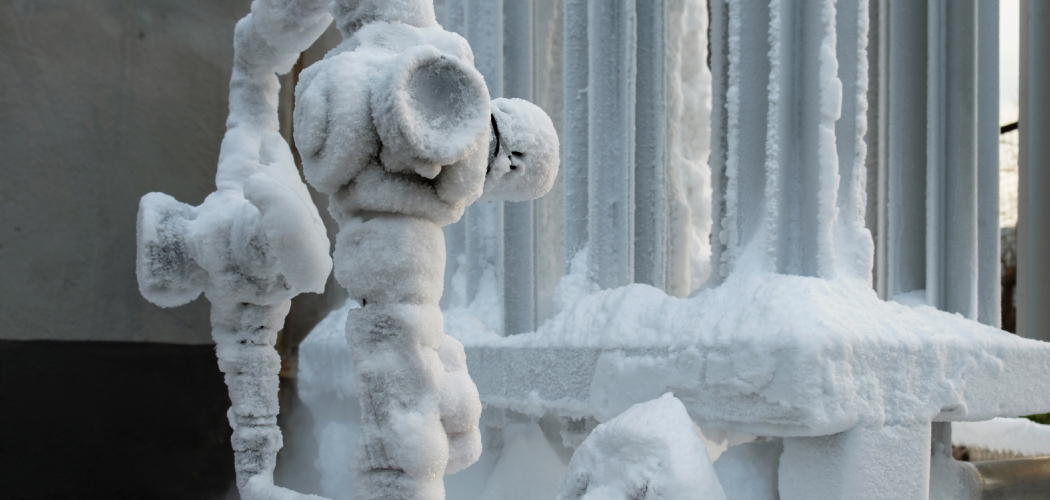When temperatures drop during winter, outdoor faucets are particularly vulnerable to freezing, leading to serious issues such as burst pipes and expensive repairs. The combination of water expansion as it freezes and the pressure it creates in confined spaces can wreak havoc on your plumbing system. Protecting your outdoor faucets from freezing is crucial in maintaining the integrity of your home’s water system.
By insulating pipes, installing faucet covers, and properly shutting off water valves, you can effectively minimize these risks and ensure that your outdoor faucets remain functional throughout the colder months. Taking these preventative measures saves money and offers peace of mind by avoiding inconvenient plumbing disruptions.
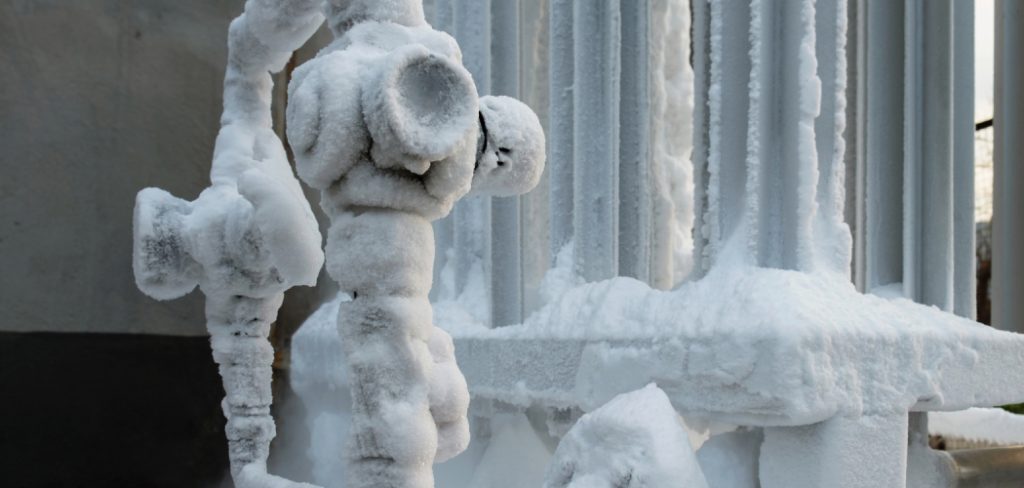
This article serves as a practical guide on how to prevent outdoor faucets from freezing, providing you with the tools and knowledge needed to protect your home during winter.
Understanding Why Outdoor Faucets Freeze
How Freezing Affects Faucets
When water inside a faucet or pipe freezes, it expands. This expansion creates immense pressure within the pipe, leading to cracks or even bursts. Once the ice thaws, any damage in the pipe or faucet can result in leaks that may go unnoticed for a time, causing water damage and costly repairs, and understanding how freezing impacts your outdoor faucets is key to preventing these issues.
Why Outdoor Faucets Are Vulnerable
Outdoor faucets are especially prone to freezing because they are directly exposed to cold temperatures. Unlike indoor plumbing, which is often insulated within your home, outdoor faucets and pipes lack this protection. Water left inside the faucet or connected pipes during freezing weather can quickly turn into ice, setting the stage for potential damage. This risk is heightened during extended periods of freezing temperatures.
Common Indicators of Frozen Faucets
Recognizing the signs of frozen outdoor faucets can help you act quickly to address the problem. One of the most common signs is no water flow or a very slow trickle when the faucet is turned on. Additionally, visible frost or ice on the faucet or surrounding pipe clearly indicates that freezing has occurred.
Materials and Tools Needed
Tools You’ll Need
- Pipe insulation foam or faucet covers
- Wrench or pliers (for removing any hose attachments)
- Outdoor faucet covers (available at most hardware stores)
- Faucet bib or shut-off valve (for winterizing)
- Insulating tape (optional for extra protection)
Optional Items for Extra Protection
- Heat tape or cables (for pipes that are exposed to extreme cold)
- Blankets or tarps (for covering large faucet areas)
These materials and tools will ensure you are prepared to protect your outdoor faucets from freezing temperatures. By applying the right combination of insulation and protective equipment, you can effectively reduce risks and extend the life of your plumbing during winter.
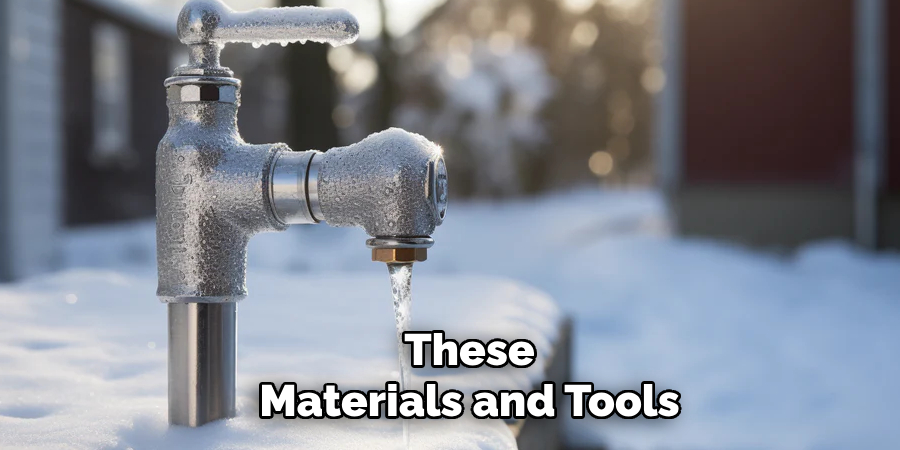
How to Prevent Outdoor Faucets From Freezing: Step-by-Step Guide
Step 1: Disconnect and Drain Hoses
Disconnect all garden hoses or attachments from the outdoor faucet. Leaving hoses attached can trap water inside, which may freeze and cause blockages. After disconnecting, drain the hoses completely to remove any remaining water before storing them in a dry place for the winter.
Step 2: Turn Off the Water Supply to the Outdoor Faucet
Locate the shut-off valve for your outdoor faucet inside the house and turn it off to prevent water from flowing to the faucet. Once the water supply is off, open the outdoor faucet completely to allow any remaining water to drain out. This step ensures that no water is left in the pipes, reducing the risk of freezing and potential damage.
Step 3: Insulate the Faucet
Use pipe insulation foam to cover the outdoor faucet and any exposed pipes. This helps retain heat and provides a barrier against cold air. For added protection, place a thick outdoor faucet cover over the insulated area. To seal any remaining gaps, tightly wrap insulating tape around the exposed pipes.
This combination of insulation techniques will help keep the faucet safe from freezing temperatures and maintain the integrity of your plumbing throughout the winter season.
Using Outdoor Faucet Covers
Step 1: Choosing the Right Faucet Cover
Begin by selecting a faucet cover that meets the demands of your climate. Look for covers made from durable, weather-resistant materials such as foam or insulated plastic. These materials are effective at blocking out cold air and preventing heat loss. It’s essential to choose a cover that fits snugly over your faucet. Measure your faucet’s dimensions to ensure the cover provides a secure, airtight fit to maximize protection.
Step 2: Installing the Cover
Once you’ve selected the appropriate cover, installation is straightforward. Position the cover over the outdoor faucet, ensuring it completely encloses the area to block out cold temperatures.
Most faucet covers come with ties, velcro strips, or adjustable clamps to secure them. Tighten these fasteners until the cover is firmly attached, minimizing any potential gaps where cold air might seep through. Proper installation is key to enhancing the effectiveness of your faucet cover.
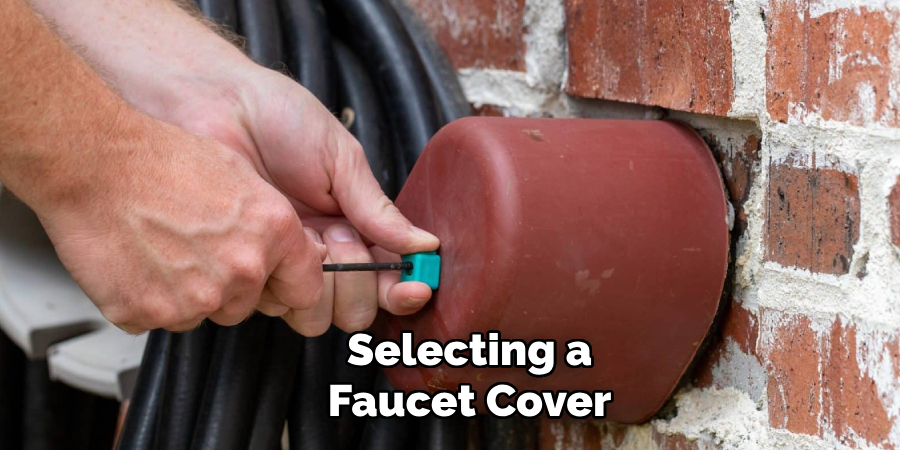
Step 3: Adding Extra Insulation
For regions with particularly harsh winters, consider reinforcing your outdoor faucet against freezing with additional insulation.
Before placing the faucet cover, wrap the faucet with foam pipe insulation, an old towel, or another heat-retaining material. This extra layer of insulation helps trap warmth around the faucet, further reducing the risk of freezing. After wrapping, install the cover outlined above to provide multi-layered protection against extreme cold.
Winterizing Exposed Pipes
Winterizing your exposed pipes is essential to prevent freezing during harsh winters. Taking a few proactive steps can save significant repair costs and ensure a steady flow of water even in the coldest months.
Step 1: Insulating Exposed Pipes
Begin by identifying any exposed pipes connected to the outdoor faucet. These are most vulnerable to freezing temperatures. Use foam pipe insulation or fiberglass insulation to cover the pipes thoroughly. Make sure the insulation fits snugly around the pipes to provide maximum protection.
For regions prone to extreme cold, consider using heat cables or heat tape to wrap the pipes. These devices provide consistent warmth to prevent any chance of freezing, offering an extra layer of security during freezing spells.
Step 2: Seal Gaps and Cracks
Inspect the area around outdoor faucets and exposed pipes for any gaps, cracks, or openings where cold air might infiltrate. Use weatherproof caulk or expanding foam to seal these openings effectively.
Pay special attention to areas where pipes enter walls or foundations, as these can be prime spots for chilly drafts. After sealing all gaps, ensure the surrounding area is adequately insulated to block out the cold entirely.
By following these straightforward steps, you can protect your home’s plumbing system during winter and avoid the inconveniences and expenses of frozen or burst pipes.

Additional Tips for Preventing Frozen Outdoor Faucets
Use Frost-Free Faucets
Consider installing a frost-free faucet to safeguard against freezing temperatures. These specially designed faucets keep the valve located inside your home, away from the cold outdoor air, ensuring water doesn’t freeze within the faucet or its connected pipes. This is an effective and low-maintenance solution to prevent outdoor faucets from freezing during winter.
Install a Shut-Off Valve
Adding a shut-off valve inside your house provides additional security for controlling water flow to outdoor faucets. By shutting off the water supply to outdoor fixtures entirely, you eliminate the risk of water remaining in the pipes and freezing. This precautionary measure is handy in areas that experience prolonged cold periods.
Cover Exposed Pipes with Insulating Blankets
Use insulating blankets for outdoor pipes or those running through unheated spaces to protect them from freezing temperatures. These wraps or blankets work by keeping the pipes’ surface temperature above freezing, thereby reducing the risk of ice formation. Ensuring all exposed pipes are adequately insulated adds an extra layer of protection against damage and helps maintain the functionality of your plumbing system during winter months.
What to Do If Your Outdoor Faucet Freezes
Step 1: Turn Off the Water Supply
If you suspect your outdoor faucet has frozen, acting swiftly to minimize potential damage is crucial. Start by turning off the water supply to the affected faucet. This step prevents additional water from entering the pipes and potentially worsening the situation. Locate the shut-off valve that controls the water flow to the faucet and ensure it is completely closed.
Step 2: Thaw the Faucet
Once the water supply is off, begin the thawing process. Use a hairdryer or heat gun to gently warm the frozen faucet and any exposed pipes leading to it. Start your focus at the faucet itself and gradually move toward the house where the pipe connects. Be cautious not to apply excessive heat, and under no circumstances should you use an open flame, as this can damage the pipes or create a fire hazard.
Step 3: Check for Damage
After the faucet and pipes have thawed, inspect them closely for any signs of damage. Look for cracks, leaks, or weak spots that may have resulted from the freeze. If you find any issues, immediately repair or replace the damaged component to prevent further complications.
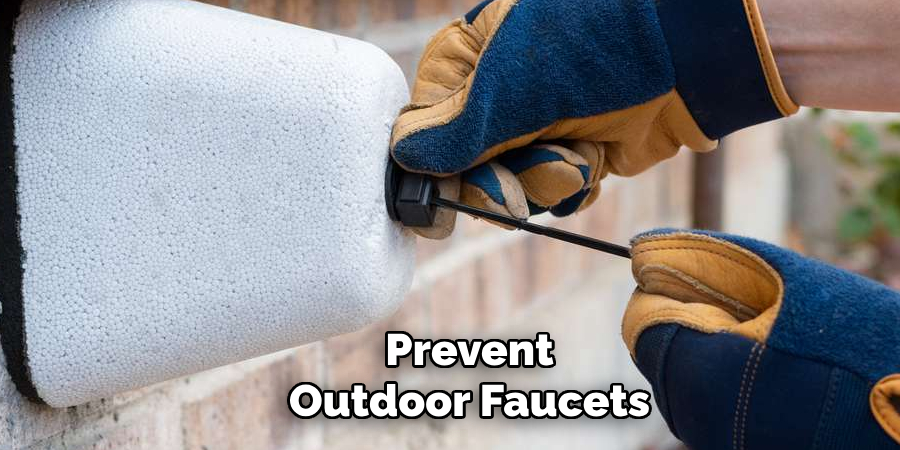
Conclusion
Learning how to prevent outdoor faucets from freezing is crucial for avoiding expensive repairs and ensuring the longevity of your plumbing. By taking proactive steps like insulating pipes, using faucet covers, and shutting off water valves, you can effectively protect your outdoor faucets from freezing during harsh winter months.
Regular maintenance and preparation are key to minimizing risks and keeping your plumbing in top condition. Remember, a little effort now can save you significant time and money later. With the right combination of preventative measures, you’ll safeguard your home against freezing temperatures.

